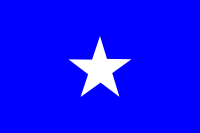Bangla Congress
Bangla Congress বাংলা কংগ্রেস | |
|---|---|
 | |
| Founder | Ajoy Mukherjee |
| Founded | 1960 |
| Dissolved | 1977 |
| Split from | Indian National Congress |
| Merged into | Biplobi Bangla Congress |
| Colours | Blue |
| Alliance |
United Front (1967-1971) Congress+ (1971-1977) |
| Seats in Lok Sabha |
0 / 545 [1](currently 531 members + 1 Speaker)
|
The Bangla Congress was a regional political party in the Indian state of West Bengal. It was formed through a split in the Indian National Congress in 1966 and later co-governed with the Communist Party of India (Marxist) (CPI(M)) in two United Front governments, the first lasting from March 15, 1967, to November 2, 1967, and the second from February 25, 1969, to March 19, 1970.
History
Mainly the Left Wing of the Bengal Congress, represented by Ajoy Mukherjee, Pranab Mukherjee, Sidhhartha Shankar Ray, ABA Ghani Khan Chowdhury revolted against the leadership of the old conservative elites of "the Syndicate" like Prafulla Chandra Sen and Atulya Ghosh.
The revolt was mainly led by younger leaders of the Congress and enjoyed widespread support among the rural landowning and trading classes as well as the middle castes of rural Bengal, such as the Mahishyas and the Sadgops who looked upon an alliance with the Proletarian Left Front as useful against the dominance of the Calcutta-oriented Congress leadership which was seen to favour the Calcutta-based large private industries and British business interests too much.
The Party had a strong base in Midnapore, Hooghly, Nadia, Murshidabad and all of North Bengal and a big plank was development of rural areas and Small Towns as opposed to the Calcutta-obsessed approach of the Congress-led West Bengal Government.
Ajoy Mukherjee, a veteran Congress leader from Tamluk, a rural area of Purba Medinipur was the Chief Minister in both governments formed by the Coalition and till date, he remains the only Chief Minister of West Bengal not to reside in a Calcutta postal address.
On March 19, 1970, the second United Front government fell as a result of the breakdown of the alliance between the Bangla Congress and the CPI(M) thanks to the land reform movement led by CPI(M) leaders Benoy Chowdhury and Harekrishna Konar which threatened the interests of the landowning Middle/backward castes that supported the Bangla Congress.
The Bangla Congress then went into rapid decline and was later reunified with the Indian National Congress.
West Bengal state assembly
1967: 80 candidates, 34 elected, 1,286,028 votes
1969: 49 candidates, 33 elected, 1,094,654 votes
1971: 137 candidates, 5 elected, 695,376 votes
Lok Sabha election
1967: 7 candidates, 5 elected, 1,204,356 votes
1971: 14 candidates, 1 elected, 518,781 votes
References
Split in a Predominant Party: The Indian National Congress in 1969
See also
- ↑ "Members: Lok Sabha". loksabha.nic.in. Lok Sabha Secretariat. Retrieved 28 September 2018.